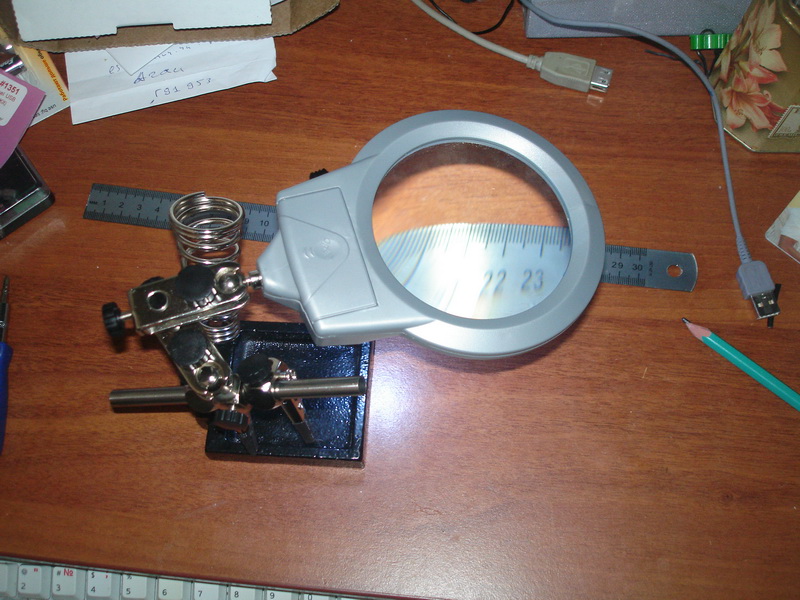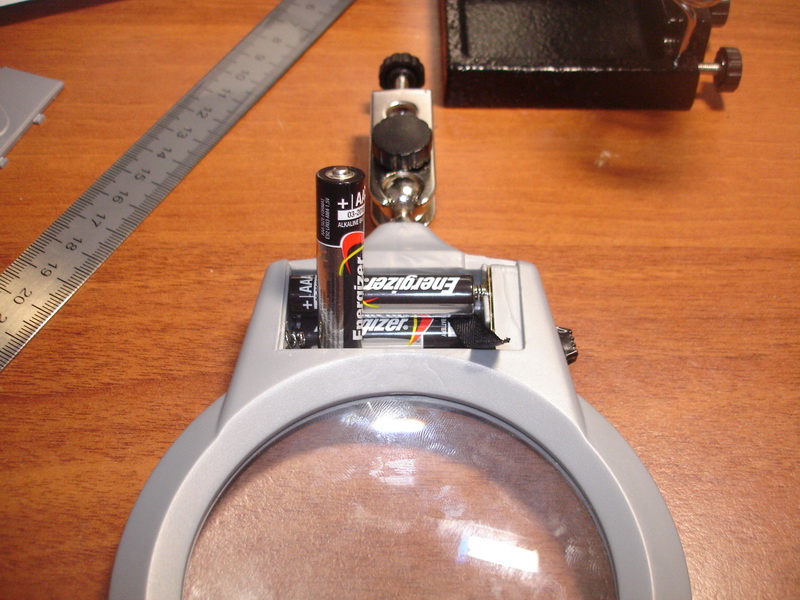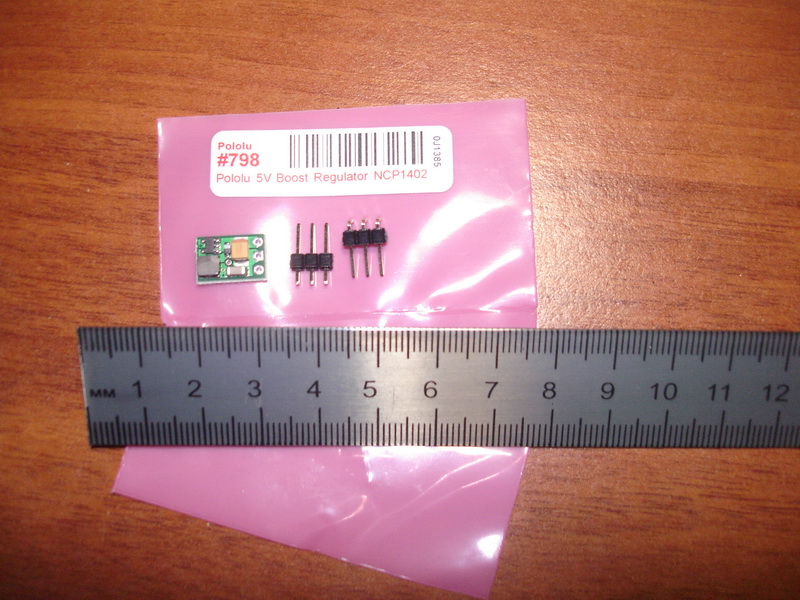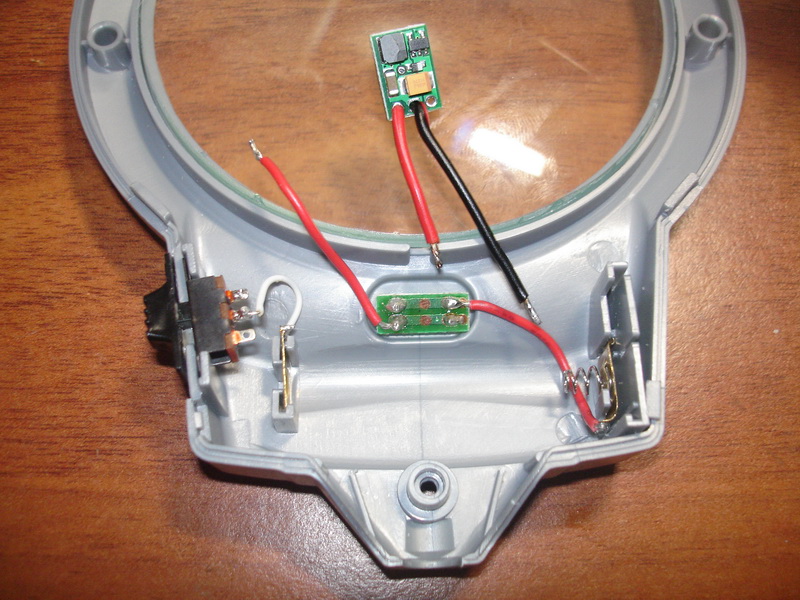Change three batteries for one
Finally, I’m tired of looking for AAA and AA batteries for numerous randomly used electronic handicrafts: a children's electronic alphabet and a talking zoo on the wall for a daughter, musical rattles for a son, etc. These devices usually consume a small current, but require the use of AAA elements in number of up to 3 pieces for each. And speculators sell them in packs of 2 or 4 pieces.
We take for experiment the illumination for the “third hand” (a tripod for boards with a lens and a backlight ZD-10M).

')
These two LEDs require three AAA elements.

So, I want to use only one battery.
Let's try to apply the following achievement of bourgeois engineering thought:

This is a small board with a size of 1 sq. Cm NCP 1402 voltage converter with the following characteristics:
Vin 0.8 ... 5V
Vout 5V (± 2.5%)
I out max 200 mA
We must pay tribute to the nato'vtsam - when they do not sow democracy and tolerance they get wonderful things. The peculiarity of this shawl is an ultra-low input voltage: 0.8 volts is declared. Typically, such converters require at least twice.
The wiring diagram is elementary. Contacts on the shawl neatly signed.
At the contact Vin we give a plus from the contact of the toggle switch (which is connected to the + battery). Contact Vout served on the LEDs. Earth connect with minus battery.
It turns out like this:


There was enough space for the converter board under the power switch (left).
Also, the battery minus contact (with a spring) was moved to ensure contact with the now only AAA battery (on the right).
We collect. We are checking.

Everything is working. LEDs are shining.
Result.
0) With a decrease in the number of batteries, the overall weight of the device has decreased.
1) You can use 1.2 volts batteries instead of 1.5 without degrading the device due to low power
2) When the device is urgently needed, it is easier to find one battery or charge one battery than three.
3) The only power source is used more efficiently. In the sense that the device will continue to work even if the battery is discharged to 0.3 Volt. To start the converter (turn on the device) you need at least 0.8 V.
Criticism.
When using such solutions you need to understand the following obvious things:
0) Cap says that the charge of one battery will die earlier than three. The law of conservation of energy has not been canceled. Consider the power consumption.
1) Something powerful with a current consumption of more than 200mA is unlikely to turn out to be powered. Those. all sorts of movable toys on the little engines disappear. Although there are more powerful converters, they have more dimensions and input voltage.
2) There is some overvoltage. The converter provides 5 volts, and three AAA batteries 4.5 volts. This is usually not significant, but it must be borne in mind.
3) Can "make noise" (not acoustic, of course). Because The converter most likely uses high-frequency voltage conversion, for sensitive devices it may be necessary to add a capacitor to the output.
4) The price of the issue. Ready scarf converter costs about 5 bucks. The Chinese counterpart could not be found, but I hope the Communist comrades will soon master the production of such devices and the price will be even lower. Although the same 150 rubles you pay for three or four good disposable AAA batteries. But if you collect yourself the cost of the parts is about 50-70 rubles.
5) It is risky to use with batteries. Many of the modern batteries "do not like" razyard below a fixed threshold.
Details about the converter NCP 1402
Experimental device.
We take for experiment the illumination for the “third hand” (a tripod for boards with a lens and a backlight ZD-10M).

')
These two LEDs require three AAA elements.

So, I want to use only one battery.
Let's try to apply the following achievement of bourgeois engineering thought:

This is a small board with a size of 1 sq. Cm NCP 1402 voltage converter with the following characteristics:
Vin 0.8 ... 5V
Vout 5V (± 2.5%)
I out max 200 mA
We must pay tribute to the nato'vtsam - when they do not sow democracy and tolerance they get wonderful things. The peculiarity of this shawl is an ultra-low input voltage: 0.8 volts is declared. Typically, such converters require at least twice.
The wiring diagram is elementary. Contacts on the shawl neatly signed.
At the contact Vin we give a plus from the contact of the toggle switch (which is connected to the + battery). Contact Vout served on the LEDs. Earth connect with minus battery.
It turns out like this:


There was enough space for the converter board under the power switch (left).
Also, the battery minus contact (with a spring) was moved to ensure contact with the now only AAA battery (on the right).
We collect. We are checking.

Everything is working. LEDs are shining.
Result.
0) With a decrease in the number of batteries, the overall weight of the device has decreased.
1) You can use 1.2 volts batteries instead of 1.5 without degrading the device due to low power
2) When the device is urgently needed, it is easier to find one battery or charge one battery than three.
3) The only power source is used more efficiently. In the sense that the device will continue to work even if the battery is discharged to 0.3 Volt. To start the converter (turn on the device) you need at least 0.8 V.
Criticism.
When using such solutions you need to understand the following obvious things:
0) Cap says that the charge of one battery will die earlier than three. The law of conservation of energy has not been canceled. Consider the power consumption.
1) Something powerful with a current consumption of more than 200mA is unlikely to turn out to be powered. Those. all sorts of movable toys on the little engines disappear. Although there are more powerful converters, they have more dimensions and input voltage.
2) There is some overvoltage. The converter provides 5 volts, and three AAA batteries 4.5 volts. This is usually not significant, but it must be borne in mind.
3) Can "make noise" (not acoustic, of course). Because The converter most likely uses high-frequency voltage conversion, for sensitive devices it may be necessary to add a capacitor to the output.
4) The price of the issue. Ready scarf converter costs about 5 bucks. The Chinese counterpart could not be found, but I hope the Communist comrades will soon master the production of such devices and the price will be even lower. Although the same 150 rubles you pay for three or four good disposable AAA batteries. But if you collect yourself the cost of the parts is about 50-70 rubles.
5) It is risky to use with batteries. Many of the modern batteries "do not like" razyard below a fixed threshold.
Details about the converter NCP 1402
Experimental device.
Source: https://habr.com/ru/post/146692/
All Articles